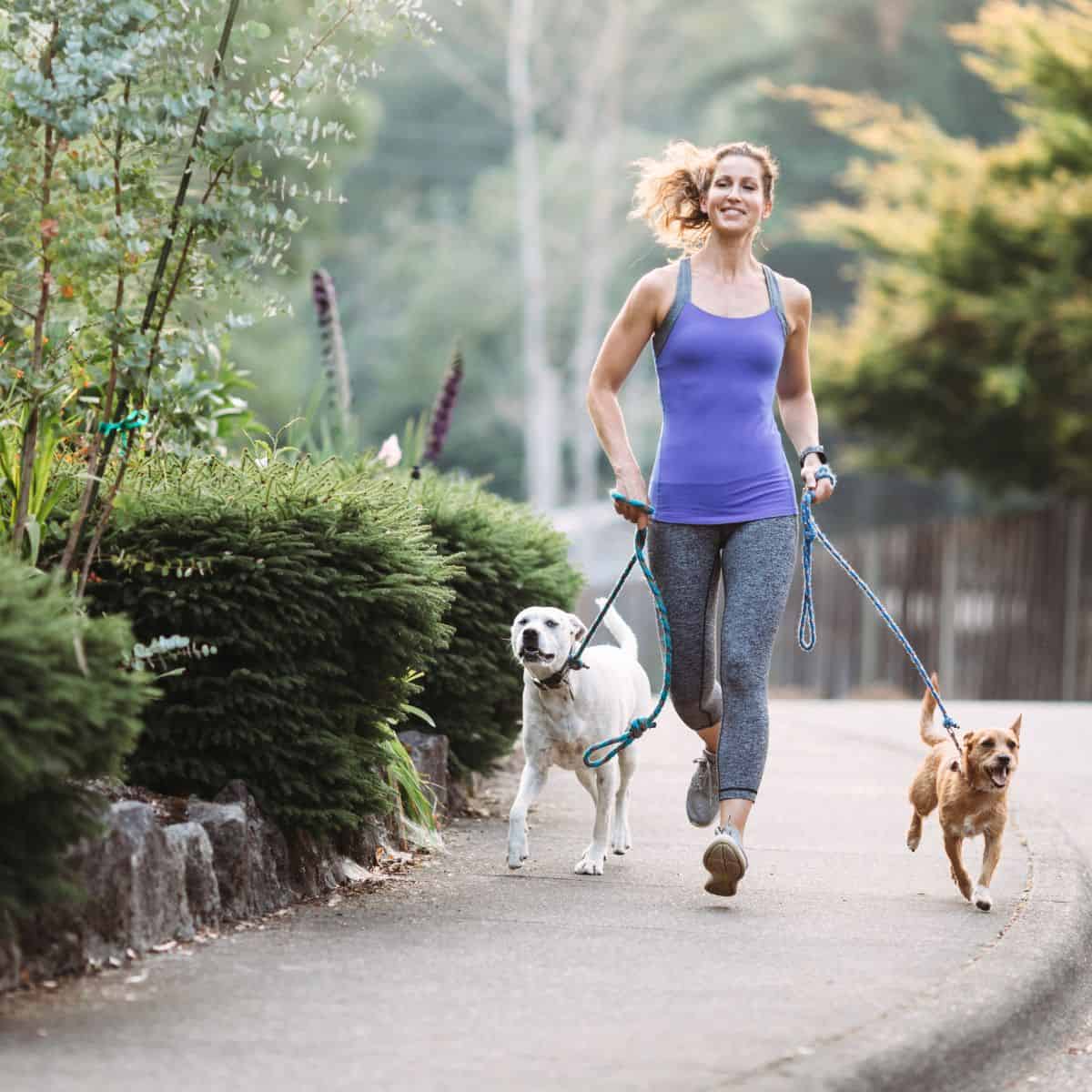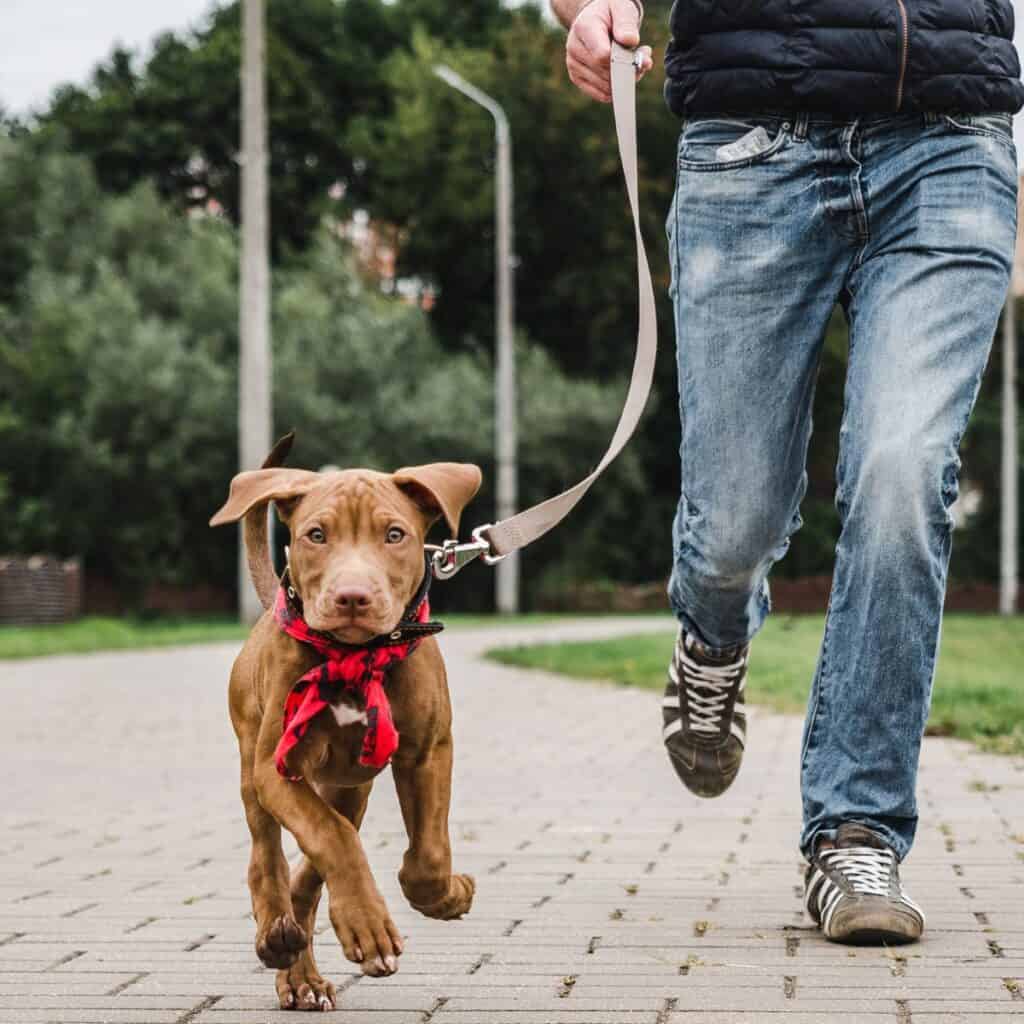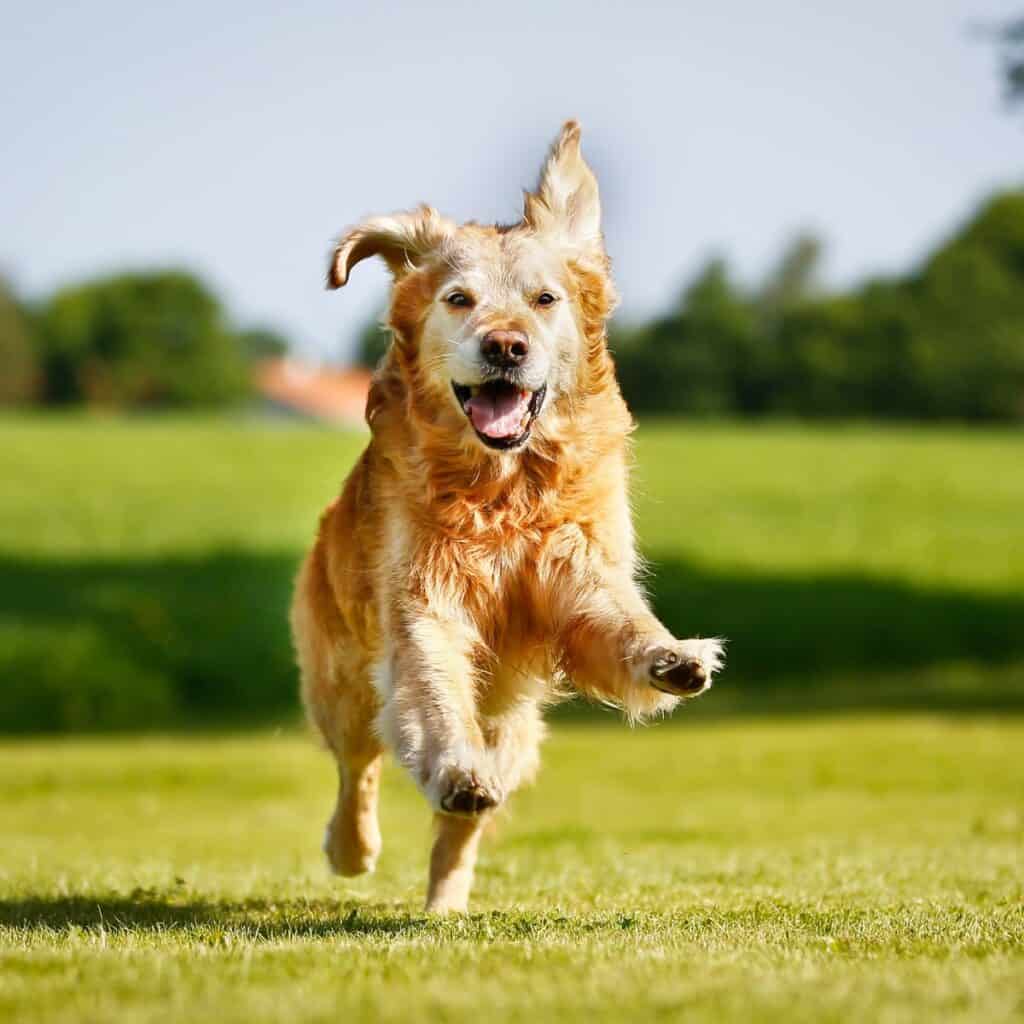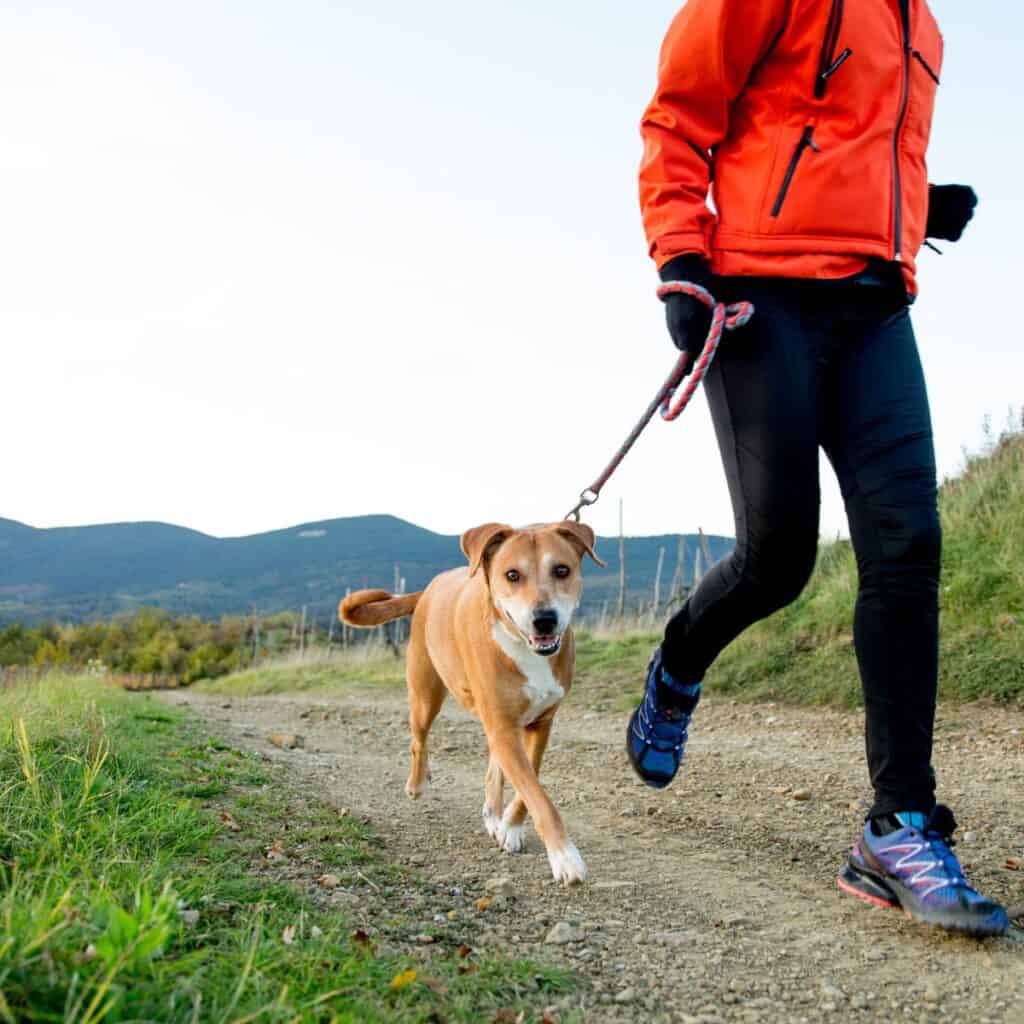Meet Sarah, a dedicated runner and proud owner of a Golden Retriever named Max. Sarah and Max have been running partners for over a year, and they both love it. Every morning, Sarah laces up her shoes and attaches Max’s leash to his harness, and they hit the pavement together.

Would you love it if your dog was a running partner as good as Max? Max initially struggled to keep up with Sarah’s pace, but with patience and consistent training, he eventually became a pro just like your dog can be. Read on to learn more about training your dog to run with you.
Training Your Dog to Run With You
Do you love running, but feel guilty leaving your furry friend behind? Or perhaps you’re looking for a way to bond with your dog while also getting some exercise. Whatever your reason may be, training your dog to run with you can be a fun and rewarding experience for both you and your pup.
Not only will it provide a great workout for you and your dog, but it can also strengthen your bond and provide mental stimulation for your furry companion. In this article, we’ll provide you with some tips and tricks for training your dog to run with you, so you can hit the pavement together and enjoy the great outdoors.
You may also like Teaching Your Dog to Play Frisbee: Will Your Dog Be the Next Disco Dog Champ?
At What Age Can Your Puppy Start Running with You?
The answer to the question of when a puppy can start running with you is not a simple one. While it’s true that puppies are energetic and playful creatures that love to run, jump and play, their bodies are still developing and growing, and intense exercise can potentially harm their developing bones and joints.
The general rule of thumb is to wait until your puppy is at least six months old before you start running with them. At this age, their growth plates should be fully developed, and they should have enough endurance and coordination to handle short runs.
As much as you may be excited to hit the pavement with your furry friend, it’s crucial to be aware of the potential risks that come with running with a young pup. Running long distances with a puppy or adolescent dog can be harmful to their growth plates, which are still developing says Dr. Austin, This repetitive high impact on their growing bones can lead to problems with their legs and increase the risk of hip or elbow dysplasia, or shoulder osteochondrosis she says.
To ensure your dog’s health and wellbeing, it’s best to wait until they are around 18 months old before beginning to run with them. By this age, their growth plates will have closed, and their bones, joints, and ligaments will have finished growing. Trust us, it’s better to wait a bit longer than to risk causing any long-term harm to your beloved pup.
However, it’s important to note that even after six months, you should start gradually increasing the intensity and duration of your runs with your puppy. Sudden bursts of intense activity can still cause damage to their developing bodies.

What Dog Breeds are Not Suited to Running
Max is a Golden Retriever, a pretty good running companion, while many dog breeds like Golden Retrievers, make great running companions, not all dogs are cut out for the job. Some dog breeds, due to their anatomy, temperament, or health issues, may not be able to keep up with your pace or handle the physical demands of running. In this section, we’ll explore some of the dog breeds that are not well-suited for running and explain why.
By knowing which breeds to avoid, you can save yourself and your furry friend from unnecessary stress, injury, or disappointment. So, let’s take a look at the “anti-runners” and learn what makes them better suited for other activities.

Here are some dog breeds that are not recommended for running:
Bulldogs, Pugs and Boxers:
Bulldogs are a Brachycephalic breed such as bulldogs (French, English), Pugs, Boxers, etc., are not suited to running (especially in warm or hot weather) due to the confirmation of their face making it harder for them to breathe. The difficulty breathing and the fact that many are shorter in stature mean that these types of dog will enjoy and walk more than a run.
Dachshunds:
Dachshunds have a long body and short legs, which puts them at risk for spinal injuries when running. They may have the energy for a run but they are better suited for short walks.
Basset Hounds:
Basset Hounds have short legs and a long body, which makes running uncomfortable for them (not to mention they may step on their ears). They are also prone to joint problems and should stick to short walks.
Greyhounds:
While some would think that Greyhounds would be a great running companion since Greyhounds are known for their speed, they actually are not. Greyhounds are sprinters and not built for endurance running. They also have thin skin, which makes them more prone to injuries.
It’s important to note that each dog is different, and some may be able to handle running better than others, even if they belong to one of the above breeds.
If you are the proud owner of one of these dogs maybe another sport would be better find some inspo with these sporty dogs on IG or try some dog water sports or dog soccer!
When Should I Stop Running With My Senior Dog?
Max is six years old and in very good shape but if you have an older dog you may wonder when you should stop running with your senior dog. My senior dog Zooey became so sad when I left her at home you wonder if they could keep going forever but as we know we have to consider our senior dog’s health differently as they age.
The safe age for a dog to run can vary depending on the breed, size, and overall health of the dog. In general, most dogs can continue to run well into their senior years, as long as they are healthy and have been regularly active. However, it’s important to keep in mind that older dogs may not have the same stamina and endurance as their younger counterparts, so it’s important to adjust their exercise routine accordingly.
As dogs age, their bodies undergo several changes that can affect their stamina. One major factor is a decrease in muscle mass and strength, which can lead to fatigue and a reduced ability to engage in high-intensity activities like running.
Additionally, older dogs may experience joint stiffness or pain, which can make running uncomfortable or even painful. Age-related changes to the heart and lungs can also impact a dog’s endurance and overall cardiovascular health. Finally, some medical conditions common in older dogs, such as dog arthritis or respiratory problems, can further limit their stamina and ability to exercise. Exercise has so many benefits for your dog, however, you may have to choose a different form other than running as they grow older.
It’s always a good idea to consult with your veterinarian to determine the best exercise routine for your senior dog and don’t forget the post run dog massage!
Dog Health Conditions That Affect Running with You
You know that feeling when you’re all set to go for a run, but your body just isn’t feeling up to it? Your dog can feel the same way too, so it’s important to make sure they’re in tip-top shape before hitting the pavement together.
First and foremost, make sure your dog is up to date on all their vaccinations and preventative care. You don’t want your run to be cut short by an unexpected illness or injury! Regular visits to the vet can also help catch any underlying health issues that may affect your dog’s ability to run with you.
Some health conditions that may affect your dog’s running ability include obesity, arthritis, heart disease, and respiratory issues. Just like with humans, carrying extra weight can make running more difficult for dogs and put extra strain on their joints. Arthritis can also cause joint pain and stiffness, making running uncomfortable for your furry friend.
Heart disease and respiratory issues can impact your dog’s endurance and breathing during exercise. If your dog seems to be struggling to catch their breath or seems to tire quickly during exercise, these may be signs of an underlying health condition.
But don’t worry, there are ways to help your dog get back into shape! Gradually increasing the distance and intensity of your runs can help build up their endurance and strength over time. And if your dog has any health conditions, work with your vet to come up with a plan to manage them and keep your dog healthy and happy.

Remember, running with your dog should be a fun and rewarding experience for both of you. By keeping your furry friend in good health and working together to overcome any obstacles, you can enjoy many happy miles together.
Step-By-Guide to Training Dog to Run With You
Now that you know the importance of ensuring your dog is healthy and ready to run with you, it’s time to get started! With a little patience and training, you and your furry companion can enjoy the benefits of running together.
In this section, we will provide you with a step-by-step guide on how to start running with your dog. We will also include training tips from leading dog trainers to ensure that both you and your dog have a safe and enjoyable experience. So, grab your running shoes and leash, and let’s get started!
Step 1: Check with your vet
Before you start pounding the pavement with your pup, it’s crucial to ensure they are in good health. Schedule a visit with your veterinarian to ensure your dog is physically able to start running with you. As leading dog trainer, Cesar Millan, advises, “If your dog has any pre-existing health conditions, talk to your vet before you begin a running routine.”
Step 2: Build Up Stamina
Just like us humans, dogs also need to build up their stamina before they can hit the ground running. Start with a slow-paced walk, and gradually increase your pace and distance over several weeks. According to Cesar Millan, “Start with short distances and gradually build up to longer runs.”
Step 3: Invest In Proper Gear
To ensure your dog’s safety and comfort, it’s important to invest in proper gear. A sturdy leash, harness, and comfortable shoes for you are essential. As leading dog trainer, Zak George, advises, “Make sure your dog is comfortable in their harness or collar and that it fits well. You don’t want them slipping out of their gear while you’re on a run!”
Step 4: Train Basic Commands
Before hitting the pavement, it’s essential to have your dog trained on basic commands such as “stop,” “heel,” and “come.” According to Zak George, “Having your dog trained on these commands can make your running experience much safer and more enjoyable.”
Step 5: Follow Your Dog’s Lead
While we may have goals in mind for our running routine, it’s essential to follow our dog’s lead. As Cesar Millan advises, “Pay attention to your dog’s body language. If they’re tired, stop for a break. If they’re not interested in running, don’t force them.”
Step 6: Hydrate, hydrate, hydrate
Just like us, dogs need to stay hydrated during exercise. As leading dog trainer, Victoria Stilwell, advises, “Always bring water and a collapsible bowl with you on your runs. This will ensure your dog stays hydrated throughout the exercise.”
By following these simple steps and tips from leading dog trainers, you and your furry friend can hit the ground running and enjoy the benefits of exercise together.
Additional Tips for Running With Your Dog:
Start Slow and Gradual:
Just like humans, dogs need to build up their endurance gradually. Start with shorter runs at a slower pace and gradually increase the distance and speed over time. Remember to take breaks and let your dog rest when they need it.
Warm-up and Cool-down:
Before and after your run, take some time to warm-up and cool-down with your dog. This can include a brisk walk or light jog, some stretching, and massage. This can help prevent injury and soreness for both you and your furry friend.
Use Proper Equipment:
It’s important to use the proper equipment when running with your dog. This includes a well-fitted harness, a sturdy leash (avoid retractable leashes), and comfortable shoes for you. Consider using a hands-free leash to keep your hands free while running.
Bring Water and Treats:
Just like humans, dogs need to stay hydrated during exercise. Bring plenty of water for both you and your dog, and take breaks to drink. Bring treats for your dog as a reward for good behavior and motivation.
Be Mindful of the Environment:
When running with your dog, be aware of your surroundings and any potential hazards. Avoid running on hot pavement, and be mindful of traffic, wildlife, and other dogs. Always pick up after your dog and dispose of waste properly.
Know Your Dog’s Limits:
Not all dogs are built for running, and some may have health issues that prevent them from running. Be aware of your dog’s limitations, and don’t push them beyond their abilities. Always consult with your veterinarian before starting any exercise routine with your dog.
By following these tips and incorporating them into your training routine, you and your dog can become running partners and enjoy the great outdoors together. Remember to have fun and stay safe!
Conclusion
Running with your dog can be an incredible bonding experience and a great way to keep both you and your furry friend fit and healthy. But Sarah also finds that running with Max isn’t just about the physical benefits. Sarah loves the time she gets to spend with her pup, and Max is always happy to have her undivided attention. They often stop to take in the scenery or play a quick game of fetch before continuing their run.
It’s essential to approach running with your dog with caution and care. Always prioritize your dog’s safety and well-being, starting with a visit to your veterinarian to ensure they are healthy enough to join you on your runs. Proper training, proper equipment, and good communication with your dog can make all the difference. With these guidelines and a little patience and persistence, you and your dog can enjoy many happy miles together. So, grab your sneakers, leash, and your furry friend, and hit the pavement for some fun and safe running adventures!
Find more dog advice and fun stories in our popular book called Motherpuppin’ Adorable: What to do when your dog is better than everyone else’s the perfect companion for navigating the best life with your dog. Learn more about this loved book.
Dog FAQs for Teaching Your Dog to Run
You can start training your dog to run with you when they are a small pup by teaching them basic commands but your will not want to actually take them on a run until they are older, for most breeds and sizes of dogs after 6-9 months at least and even then start slowly and confirm with your vet.
Whether or not it is good for dogs to run with you will depend on their breed, size and age which will all need to be taken into consideration. Various breeds of dogs find running easier such as Golden Retrievers, German Shepherds, and Labradors are great to run with and good dogs to run with you.
If your dog is a good runner and of the breed, size and stamina to run with you then you can certainly run with him everyday, if he is like our dogs he will look forward to it and will be sad to actually miss a day of running.

